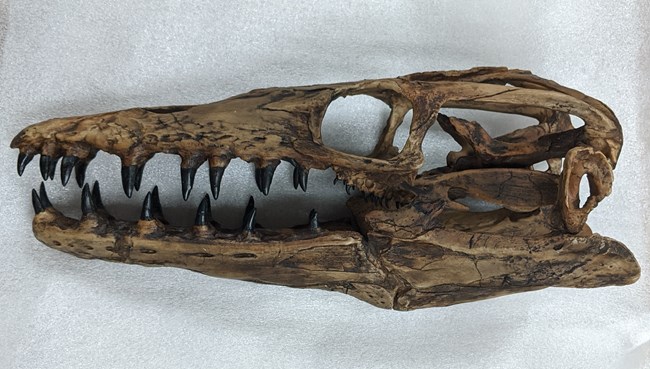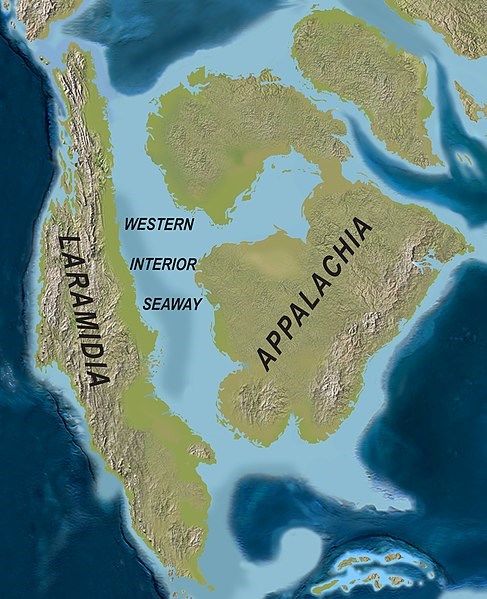Part of a series of articles titled Badlands Geology and Paleontology.
Previous: Women & Paleontology in the Badlands
Next: The Big Pig Dig
Article

Thomas Miller (c) / Badlands Natural History Association
Mosasaurs are a group of marine lizards that would have lived in the Badlands area from about 75-69 million years ago. When they were alive, mosasaurs could reach lengths of up to 50 feet, which is roughly the length of a bus! Mosasaurs were top predators of the world’s oceans and would eat anything they could catch.
The modern relatives of mosasaurs are snakes and monitor lizards, both of which live on land. When mosasaurs evolved from a terrestrial lifestyle to a marine one, they developed webbed paddles for swimming. Early mosasaur ancestors probably weren’t fully marine like a true mosasaur – it’s likely that they fed in shallow coastal waters, only returning to land for resting and breeding like iguanas do today. Mosasaurs, like their relatives, were scaled. Their scales were slightly smaller than those of the prairie rattlesnake, an animal which lives in Badlands National Park today.

NPS Photo
Mosasaurs lived in the ocean. It’s likely they preferred shallow waters for the abundant prey which could be found there, but their anatomy suggests that they would also have been excellent open-water swimmers. By the end of the Cretaceous Period, some mosasaurs had even adapted to freshwater environments. This was shortly before the mosasaurs and their more famous land-based cousins (dinosaurs) went extinct.
Mosasaurs were huge animals, and they needed to eat in order to sustain their huge size. Paleontologists have discovered the preserved remains of mosasaur stomachs which contain food like fish, sharks, cephalopods, birds, and even other mosasaurs. It’s likely that mosasaurs weren’t picky and would eat pretty much anything which could fit into their enormous mouths – which, it turns out, was a lot.
These creatures spent much of their time hunting, but they also had to worry about being hunted. There’s not much that could have preyed upon this gigantic creature, but bite marks and mangled paddles of fossil mosasaurs suggest that mosasaurs often fought (and ate) each other. Young mosasaurs also had to avoid predators like sharks and giant predatory fish.
Mosasaurs traveled about the ocean using their long, muscular tails. In some mosasaurs, the tail made up more than half of the body length and could contain 100 vertebrae. A mosasaur would have used a sweeping side-to-side motion to propel themselves through water. This method is energy-inefficient, so it’s likely that mosasaurs couldn’t swim for very long at high speeds.
Mosasaurs likely gave birth to live young. Scientists reached this conclusion when a mosasaur skeleton containing five unborn young in its abdomen was discovered in South Dakota. The maximum number of young in one birth was likely around four or five. Although mosasaurs were solitary animals, it’s possible that mothers may have lived in groups to protect their young from sharks and giant predatory fish.

Open Source photo from Sampson, Scott D. et al (New Horned Dinosaurs from Utah Provide Evidence for Intracontinental Dinosaur Endemism)
Many of the earliest mosasaur fossils were discovered in South Dakota. It’s possible that the first mosasaur discovery of the West was made by Lewis and Clark in Gregory County, just 200 miles from the Badlands. In Badlands National Park, mosasaur fossils have been found in the Pierre Shale, a rock unit laid down in the Western Interior Seaway roughly 75-69 million years ago.
The Western Interior Seaway was a shallow inland sea that stretched from the Gulf of Mexico all the way to the Arctic Ocean, cutting the North American continent in two. The ocean would have reached a depth of roughly 400 meters where the Badlands lie today, and the ocean temperatures of the Western Interior Seaway would have been similar to those in the modern Gulf of Mexico.
The Western Interior Seaway would have covered the Badlands in the Late Cretaceous, when dinosaurs were roaming the earth. However, no dinosaurs appear in the rocks within Badlands National Park. They couldn’t swim into the Western Interior Seaway, so their bones were not preserved as fossils here. Instead, the Badlands contains marine fossils from this time period; mosasaurs, ammonites, and baculites.
Part of a series of articles titled Badlands Geology and Paleontology.
Previous: Women & Paleontology in the Badlands
Next: The Big Pig Dig
Last updated: November 10, 2020